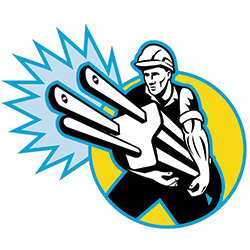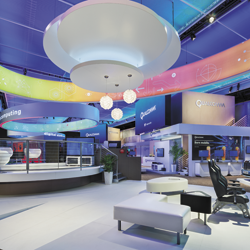|
exhibiting 101
 Exhibit Flooring Dos and Don'ts
Whether your footprint is a pint-size stand or an enormous exhibit, use these flooring-related tips to maximize the
impact of your underfoot inches. By Betsy Earle
In a recent conversation, someone compared an exhibit's back wall to a magazine ad. He elaborated that a back wall is essentially "paid-for real estate" for messaging, and that any unutilized space is wasted money. I share this little anecdote because when I sat down to write about exhibit flooring, I realized it holds true for this medium as well. Your stand's flooring is indeed part of the message you're communicating to your customers, so it should be an important consideration for your program. Yes, ordering standard show carpet is always an option, but a little forethought and creativity – and likely fewer dollars than you might expect – can result in an exhibit floor that complements your brand, enhances your stand's design, and imparts subtle and/or literal marketing messages.
I'm sure that at this point many exhibitors with small booths or tabletop displays are thinking, "My footprint is tiny, so it doesn't make sense for me to invest much effort or money on flooring." While I understand that mindset, consider this: The vast majority of your small-booth neighbors likely have the same opinion, so imagine how much you'll stand out if you put just a little thought into your flooring treatment. On that note, regardless of whether you exhibit in a 10-by-10 in-line or a massive island, here are some of my dos and don'ts when it comes to planning your exhibit's flooring. – Don't go "black tie."General service contractors almost always offer a standard rental carpet in colors that are basically "the same, only different" at every show. You'll see the typical selection – e.g., black, red, blue, gray, and green – and often something called "tuxedo" or "salt and pepper." I strongly recommend choosing a color other than this final option, as it's frequently what most exhibitors go with, resulting in aisle after aisle of dull-as-dishwater flooring. Maybe it's because I go to so many trade shows, but when I see a sea of speckled black-and-white carpet, I get an instant impression that the exhibitors didn't put much planning into their trade show appearance. + Do choose flooring that is consistent with your brand or the theme of your exhibit.Novice exhibitors sometimes forget that carpet, rolled vinyl, luxury vinyl tile, and more can be ordered in hues that closely match your company's corporate colors. You can also choose flooring styles that complement the theme of your booth, which reinforces your design scheme and results in a cohesive, immersive environment. At a recent health-care show, I saw a booth that was uniformly the same shade of purple, right down to the carpet and the hospitality station, where company reps were handing out plum-colored candies. It was, in my opinion, a sterling example of how flooring can bolster branding. Shortly thereafter, at a different show in New Orleans, I came upon another exhibitor whose booth featured a diner theme complete with menus, jukeboxes, and a floor of black-and-white checkered tile. The level of care that went into this stand no doubt communicated a subliminal message to attendees: "We paid attention to all the details of our exhibit, just like we'll pay attention to all of your needs." – Don't differentiate your flooring too much.I realize this tip may seem contrary to my earlier advice, but I'd be remiss if I didn't share that many studies have shown that attendees are less willing to enter an exhibit if its flooring is vastly different from what's in the aisle. Psychologically, showgoers interpret this difference as a barrier to entry, which can result in less booth traffic. For instance, an exhibitor with a large island stand at the American Association of Ophthalmology Show placed a presentation theater near the show aisle. Unfortunately, the exhibit's carpet was shade of beige so pale it was practically white, and the aisle carpet was extremely dark. I stood by and watched as scores of curious passersby walked up to the edge of the booth to listen to the presenter, but only a very small number stepped inside. So what's the lesson? Check the Quick Facts in the exhibitor manual to see what color the aisle carpet will be and choose something different – but not so different that it deters people from entering. + Do think about mixing materials.Using more than one type of flooring to define key areas within your booth opens up a plethora of options that won't necessarily add significant cost. While you don't want your floor to look like you cobbled it together from scraps and remnants, combining two flooring mediums, such as vinyl and carpet, can help you clearly delineate presentation, product-demonstration, and/or meeting spaces. I once had a client who was launching a stainless-steel ventilation hood at an important show. To spotlight his new product in the exhibit, my team used a stencil to cut a circle out of his teal carpet and then inlaid a piece of dark vinyl in that space. The glossy vinyl brilliantly complemented the hood's shiny finish, and having the product staged on top of a different flooring medium made it clear to booth visitors that this was a noteworthy part of the exhibit. – Don't rule out raised flooring.If you've longed for the many advantages of a raised floor – e.g., easier wire management, a sense of permanence, and a dose of European flair – for years but have balked at the price, there's good news: Raised flooring costs far less to procure and takes less time to install than it did 10 years ago. That being said, remain cognizant of how the significant additional weight will impact your material-handling bill. And while setup times have decreased, some raised-flooring systems are easier to install than others, meaning you could be setting up your installation-and-dismantle team for quite an on-site challenge if you don't know what you're getting them and yourself into. So before you make a selection, carefully review the installation guide and ask the supplier to provide estimates on I&D time and labor requirements. + Do consider attendee safety and accessibility.If you're using double padding under your carpet, be sure to taper the pad at the edges of the booth to reduce trip hazards and challenges for people in wheelchairs. I have witnessed attendees stumbling over these perimeter carpet "step-ups" on more than one occasion. And if you are employing a raised floor, remember that the Americans with Disabilities Act mandates that your exhibit include a wheelchair-accessible ramp with a slope no steeper than 1:12, i.e., your ramp needs to be 12 inches long for every inch of rise leading up to your floor. The last thing you want is to appear unwelcoming. – Don't think exhibiting in a small space means having no creative flooring opportunities.Tabletop and 10-by-10 exhibitors have numerous space-conscious, low-cost ways to augment their flooring. Custom adhesive floor decals can be added to carpet and vinyl to call out new products, hashtags, brand taglines, and more. Just be sure the carpet isn't too plush, which could result in a damaged decal as soon as a person wearing a pair of heels enters your booth, and follow show rules and keep your floor-based branding solely in your booth space and out of the aisle. Gobos, i.e., audiovisual elements that project directed beams of light through a stencil engraved with images and/or text, are another way to add your marketing messages to the floor. Carpet, vinyl, and foam tiles are a great way to create a custom floor without breaking the bank. A modular system such as this packs neatly into a modestly sized box and can be easily scaled up and down to accommodate a range of footprints. Finally, for all the tabletop warriors out there, why not order a branded floor mat that can fit into the same shipping container as the rest of your display? This will not only create an additional opportunity to display your company's logo, but will also set you apart when none of your fellow tabletop exhibitors roll out a welcome mat. My final piece of advice is to always think of your exhibit – regardless of its size – as a stage, and remember that your flooring is a part of that stage. So don't let something you've chosen at the last minute spoil or detract from your production. There are lots of ways to get creative with your space, so let your imagination run wild. E  Betsy Earle, CTSM
Betsy Earle, CTSMmanaging director and founder of Event Driven Solutions LLC. Earle obtained her MBA at the University of Miami and earned her Diamond-level CTSM designation in 2018. Exhibiting101@exhibitormagazine.com
|
|
|
||||||||||||||||||||||||||||
|
|
||||||||||||||||||||||||||||
|
TOPICS Measurement & Budgeting Planning & Execution Marketing & Promotion Events & Venues Personal & Career Exhibits & Experiences International Exhibiting Resources for Rookies Research & Resources |
MAGAZINE Subscribe Today! Renew Subscription Update Address Digital Downloads Newsletters Advertise |
FIND-IT Exhibit & Display Producers Products & Services Supplier to Supplier All Companies Compare Get Listed |
EXHIBITORLIVE Sessions Certification Exhibit Hall Exhibit at the Show Registration |
ETRAK Sessions Certification F.A.Q. Registration |
EDUCATION WEEK Overview Sessions Hotel Registration |
CERTIFICATION The Program Steps to Certification Faculty and Staff Enroll in CTSM Submit Quiz Answers My CTSM |
AWARDS Sizzle Awards Exhibit Design Awards Portable/Modular Awards Corporate Event Awards Centers of Excellence |
NEWS Associations/Press Awards Company News International New Products People Shows & Events Venues & Destinations EXHIBITOR News |
||||||||||||||||||||
|
||||||||||||||||||||||||||||






